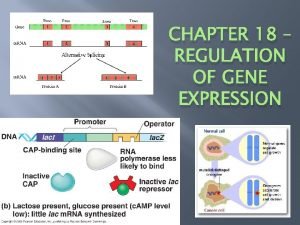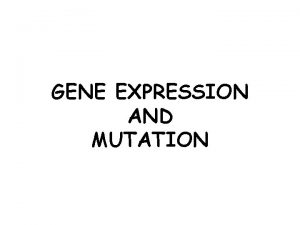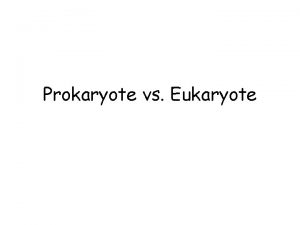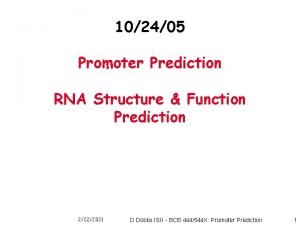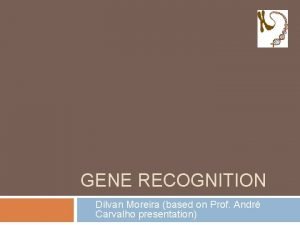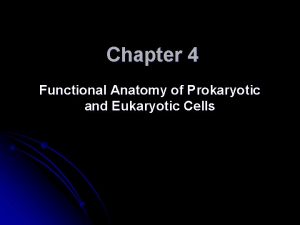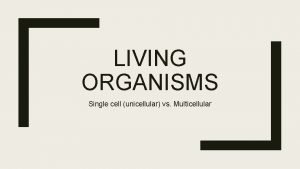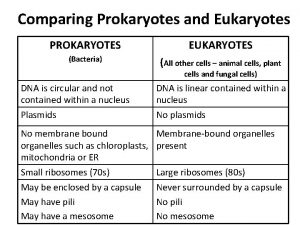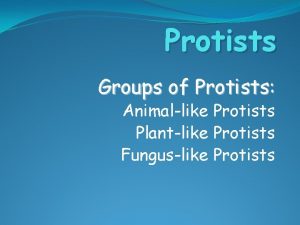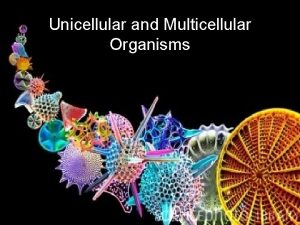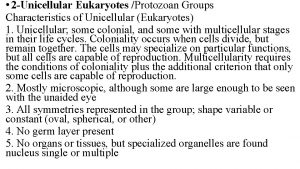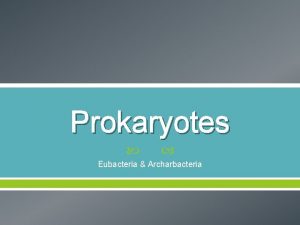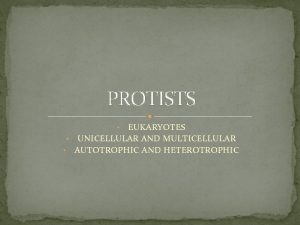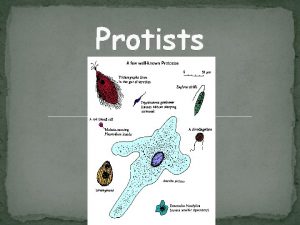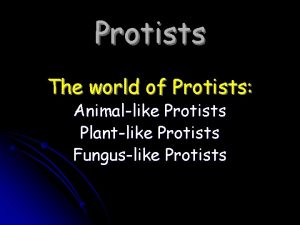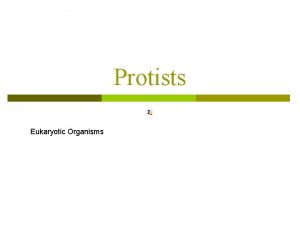All living things Prokaryotes Eukaryotes Protists unicellular eukaryotes



















- Slides: 19

All living things Prokaryotes Eukaryotes Protists (unicellular eukaryotes) Plants Animals Fungi


Prokaryotic cells (prokaryotes) • Do not have a nucleus--their DNA is spread through the cell • Do not have membrane-bound organelles (no vacuoles, no lysosomes, no Golgi, etc. ) • Are known as the BACTERIA!!! • Are always UNICELLULAR



Eukaryotic Cells (eukaryotes) • Larger and more complex than prokaryotes • They have a NUCLEUS in which their genetic material is separated from the rest of the cell • They also have membrane-bound organelles like Golgi apparatus, ER, lysosomes, etc. Eukaryotes: plants, animals, fungi, protists (unicellular eukaryotes)

Types of Eukaryotes: Animal vs. Plant Cells Animal cells Plant cells • No cell walls (only cell/plasma membrane) • No chloroplasts • Many small vacuoles for storage • Cell wall (gives rectangular shape) and cell/plasma membrane • Chloroplasts for photosynthesis • One large central vacuole





Why are all cells so small? • Cells are usually 2 -200 micrometers in diameter • Why am I not just one big cell? • Would I be able to function if I were just one big cell? • What advantages does being unicellular offer? • What advantages does being multicellular offer?

Mycoplasma—one of the smallest cells ever found Amoeba proteus– one of the largest cells ever found

There are limits to cell size!!! 1. The process of diffusion limits cell size Diffusion: movement of materials (like food or waste) from high concentration to a low concentration. Why? ? A. Cells need constant supplies of materials to perform their duties. They usually do this by diffusion into the cell. B. Cells also need to get rid of waste. They usually do this by diffusion out of the cell.

So what’s the problem? Diffusion is only efficient when it is used over short distances. Cells will not get the materials they need to live quickly enough if they are too large.

There are limits to cell size!!! 2. The amount of DNA a cell has limits size. • Most cells have only one nucleus that contains DNA. • If cells get too large, there is not enough DNA to program its metabolism and to make all of the proteins that the cell needs. • The largest cells have more than one nucleus to allow them to function…but even these cells have limits to their size

There are limits to cell size!!! 3. And finally…a cell’s surface area-tovolume ratio limits size. • As a cell’s size increases, its volume increases much faster than its surface area • Volume = 4/3 pr 3 Surface area = 4 pr 2 • If the cell membrane does not have enough surface area, oxygen, nutrients and wastes would not be able to diffuse in and out of the cell quickly enough…and the cell would die!

So, our cells DIVIDE! • A cell divides into two daughter cells. • Before a cell divides, it replicates (copies) all of its DNA, so that each daughter cell gets one complete set of genetic information.

The Cell Cycle During the cell cycle: The cell grows (G 1 of Interphase) DNA is replicated (S of Interphase) Cell prepares for division (G 2 of Interphase) Nucleus divides (Mitosis!) Cytoplasm divides (Cytokinesis) G 1, S, G 2 are together known as INTERPHASE, the time between cell divisions.
 What is the smallest living unit in all organisms?
What is the smallest living unit in all organisms? What are the 7 life processes of all living things
What are the 7 life processes of all living things Lac operon inducible or repressible
Lac operon inducible or repressible Transcription in prokaryotes vs eukaryotes
Transcription in prokaryotes vs eukaryotes Prokaryotes vs eukaryotes gene regulation
Prokaryotes vs eukaryotes gene regulation What cell type
What cell type Diff between prokaryotes and eukaryotes
Diff between prokaryotes and eukaryotes Cytoskeleton nickname
Cytoskeleton nickname Prokaryotes and eukaryotes
Prokaryotes and eukaryotes Eukaryotic vs prokaryotic
Eukaryotic vs prokaryotic Prokaryotes vs eukaryotes
Prokaryotes vs eukaryotes Multiple choice questions on prokaryotes and eukaryotes
Multiple choice questions on prokaryotes and eukaryotes Gene prediction in prokaryotes and eukaryotes
Gene prediction in prokaryotes and eukaryotes Prokaryotes vs eukaryotes chart
Prokaryotes vs eukaryotes chart Prokaryotes and eukaryotes
Prokaryotes and eukaryotes Prokaryotic vs eukaryotic cells venn diagram
Prokaryotic vs eukaryotic cells venn diagram Is a staphylococcus cell prokaryotic or eukaryotic
Is a staphylococcus cell prokaryotic or eukaryotic Anatomy of prokaryotes and eukaryotes
Anatomy of prokaryotes and eukaryotes Uni and multicellular organisms
Uni and multicellular organisms Unicellular vs multicellular
Unicellular vs multicellular




